5 Hacks to Learn Languages by Reading Literature
Nothing is better than a great book. And, if it is a foreign book? Even better!
You can learn a lot from reading books in your target language. You can benefit from a book’s message and equally from its language. In other words, a book can improve your way of life and your language learning at the same time.
So, what’s the best way to read a book in your target language?
A language is not only grammar and vocabulary. A language is a completely different lens on the world. This means that when you’re reading a book in another language, the text is not only content but also shape. The words and expressions that were chosen by the author can be a great source of instruction both in language learning, and in giving you a new view of the world.
Are you convinced that it’s a good idea to read literature in other languages?
Remember that literature doesn’t automatically equal complex. Children’s literature can be both simple and profound – and is ideal for beginner learners.
In this article, I will show you five simple hacks that you can use to help you learn a language more effectively through reading literature.
Are you ready? Let's begin!
1. Keep a Dictionary Close to Hand
Looking up words you don’t know in a dictionary is the most simple strategy, and also one of the most effective. This method consists of reading the text, underlining unknown vocabulary, looking up these words in a reliable dictionary, then writing down their meanings.
I have applied this technique hundreds of times, and on the way I discovered two important strategies that substantially improved my results.
The biggest mistake I made was writing notes in any notebook or on any piece of paper and then forgetting them in some drawer. If you do that, your effort will be lost, because you will have access to this vocabulary only once. It is necessary to have a reliable notebook. Even if you mix all the subjects you study in a single notebook, it will not be a problem, as long as all your notes are easily available.
This leads to my second strategy, which is to keep a pocket notebook. This is a small notebook, which fits in your pocket, so that you can carry it around when you are not at home. This way, while you are waiting for a bus, on the subway, standing on a line or sitting in a waiting room, whenever you have idle time, you can to review your notes.
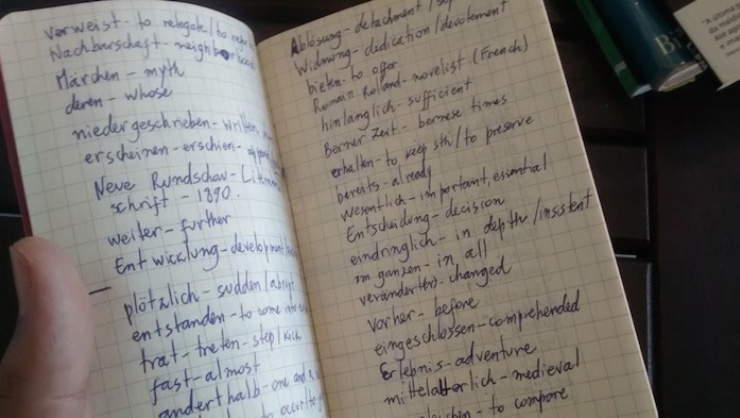
Nowadays, there is the option of a virtual notebook. Evernote is a virtual notebook that works on your smartphone. You can create notes with text, audio, checklists, photos, or anything else you want to remember. It’s very practical for day to day life, and perfect for jotting down vocabulary.
How can you remember all the vocabulary you’ve collected in your notebook? I recommend using Spaced Repetition Software such as Anki or Memrise. These flashcard applications are the most effective way to learn vocabulary, as they prompt you to remember words when you are on the verge of forgetting them.
2. Comparative Reading: Keep Two Books Side by Side
This strategy is more work than keep a dictionary to hand. Nonetheless, it is absolutely worth it. I call it “comparative reading”, It involves reading the original book and a translation at the same time.
This method is not solely about reading. It is also about taking notes. What kind of notes? Well, writing down interesting excerpts, commentaries, vocabulary, everything you figure will help you to learn even more. Again, these notes need to be taken in a reliable notebook, and should be easily available for future reference.
Speaking of notes, I’d like to share part of my notebook with you. It has some scribbles and probably some mistakes, but that's how things work. These notes are from Siddhartha, by Hermann Hesse, my favorite German writer. Note that there are several comments on the narrative and only two excerpts on this page. I tried to pick a page that was not scribbled on so much.
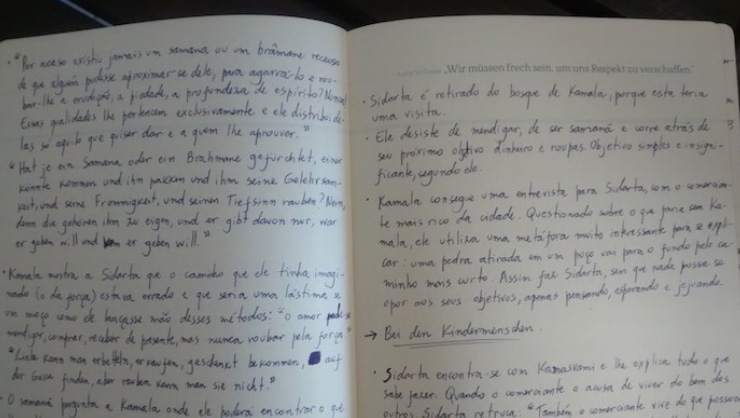
I admit that I have not read very many books this way and only used this method for the German language. One of the books I read applying this technique was “Der Steppenwolf” (The Steppenwolf) and it took me more than twice as long as usual.
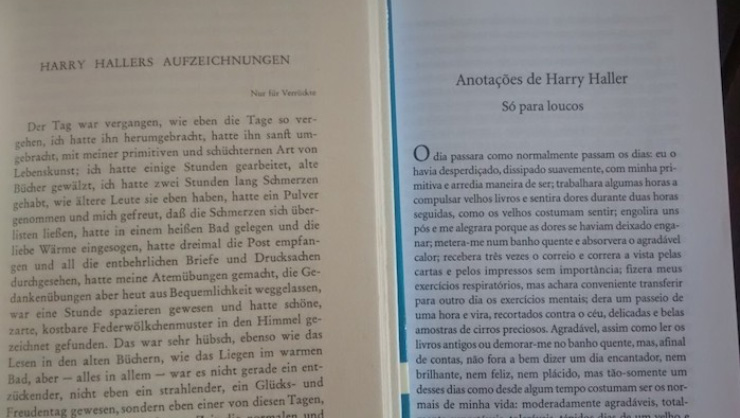
Another way to apply this strategy is to use bilingual books. This is easier because you only need to handle one book at a time. But, you still have to take notes and follow the same rules: write your notes in a reliable notebook. Extract interesting passages, great sentences, and new vocabulary.
For the first book I read in French, I applied this technique. I had just entered university, I had never done a French course in my life and only knew enough to pass the entrance exam due to my studies three months before the exam. Digressions aside, this is the book I read in two languages:

Needless to say, reading a book in two languages is a really interesting and pleasant experience. You can read a book you love in a language you love – and learn more about both of them at the same time. How wonderful is that?
3. Read Comic Books (Pictures Aren’t Cheating!)
It is true … I started reading French with Rimbaud, but I did not start Italian with Ungaretti. I was only 9 years old when I started to learn Italian and at the time, I was a voracious reader of comics. When I turned 10, I received a fabulous gift for Christmas: a series of comic books in Italian, which an Italian friend of mine sent via mail.
What bliss! Just imagine. Now, I could read the type of book I enjoyed the most, in the language I was learning! I felt amazed at how those magazines had come to me from the country of Italy, so far away…
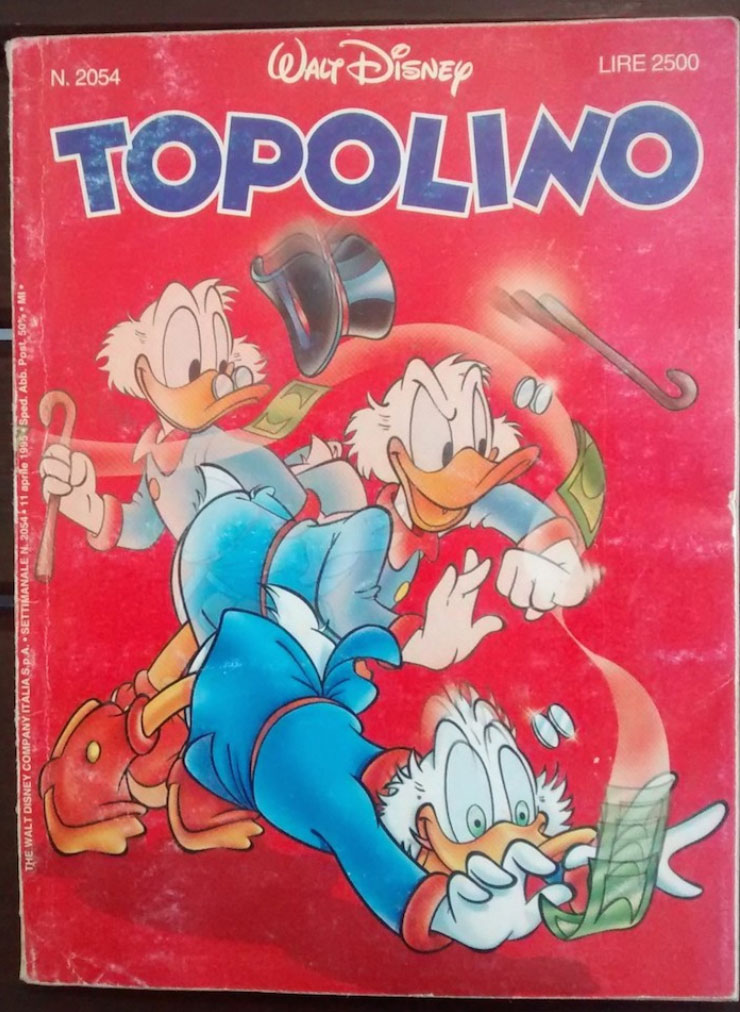
I used to read it a lot. To this day, I enjoy reading comics, not just comic books, but also comic strips. The image-text combination makes it easier to understand the language I’m learning. Moreover, some comic strips can arouse a great feeling of sensitivity just like a beautiful phrase in a book.
Reading comics is a fun way to study, with wit and humour. It is worth spending a little time to read comic strips in other languages. I can show you an example. What do you think of this comic strip written in Spanish?
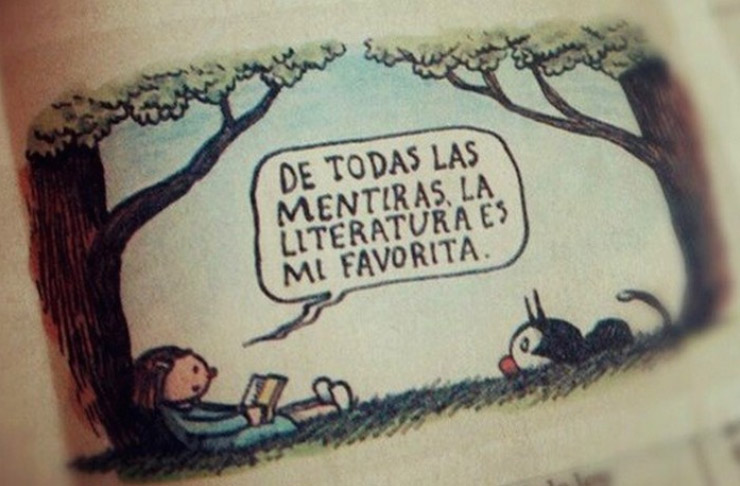
4. Read While Listening to the Audiobook
This is my favorite method! Reading while listening is one of the best ways I have found to study a language. Just as with the comparative reading strategy, you need to be ready to manage two books at a time, in this case, two different forms of media. But I assure you, nothing is better than listening to a native speaker while you follow the text.
Listening and reading at the same time is just a matter of habit. You’ll get used to it faster than you think. I know it may sound crazy, it looks like you will not be able to concentrate on both at once, but if you try, you will see that is not so difficult.
Listening as you read will improve your word-pronunciation association. You’ll begin to realize that you were pronouncing words incorrectly or that one word has more than one pronunciation.
You don’t have to start with a novel. Reading and listening to a poem at the same time can be a great way to start applying this technique.
A final remark: this method also works great when you are unable to focus on a very boring book, required by your university. I cannot remember how many books I have read in this way and for that reason. From Shakespeare to Proust, all the books that I considered boring or difficult were read exactly like this.
Worried about the cost of audiobooks? LibriVox is your solution. Librivox is a free resource with audiobooks in various languages and from many different authors. Of course, it is just classical authors, because their works are free of copyright.
5. Use Easy Reading Books for “Facilitated Reading”
Is Jane Austen too hard for you? Why don’t you try an adapted version for English learners? Easy reading books are a great way to learn a language. I call it “facilitated reading”.
Famous books adapted for language learners mean you can dip into great literature while developing your language skills. And the best part? They are divided into levels – from elementary to advanced. This means that even if you already are an intermediate reader, you can benefit. You don’t have to retrocede to a lower level to read an adapted book.
The greatest benefit that you get is that the book has been written with the purpose of teaching the language. Many of them have comprehension, grammar, and vocabulary exercises.
A second positive point is the possibility of reading with audio, as the vast majority of these books come with a CD. This way, you can apply my favorite strategy (see number 4, above), following along with a native speaker.
Easy reading books aren’t only available in English. A quick Google search will help you find easy reading books whatever your target language.



Social